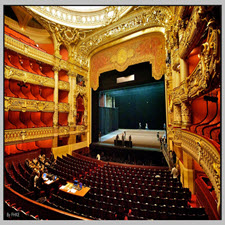Eastern Theatre,Western Theatre
ABSTRACT
In the East, a play is a narrative performance. For an Eastern performer, it is natural for him to play the role of someone else or demonstrate something other than the self. With the help of the allusion and exaggeration inherent in the art of acting, and by distancing oneself from the role, the actor thereby easily makes the character palpable. Contemporary European theater, by understanding and analyzing these very aspects of acting, on the one hand has helped originate the idea of “role distancing,” and on the other, it has become the foundation of “ritual theater.” However in both Western and Eastern theater, neither “role distancing” nor “ritual” are the sought after goals, but rather the inherent and natural dialect of theater. It therefore follows that although the feelings portrayed are real, the roles are not so, and it is normal for the actors not to become the characters they portray. They do not pronounce, “We are them!” but only give us, the audience, and news concerning the “role” or narrate the role‟s character to us. Hence it is also natural for the actor to observe the role he is portraying and, by emphasizing both the good and bad traits of the role‟s character, incite the audience‟s approval or disapproval. So it is natural for the actor, whose whole craft rests in being able to create different imaginative objects and mental images in the minds of the viewer, in the intervals and intermissions of being in character, to be able to ask for “a glass of water to regain his breath”; redo his make-up, or indeed openly read his entire role from a written script. The actor does not mean to imply that what is actually occurring on stage is reality; he is only relating a reality that has already occurred.
INTRODUCTION
Although “role distancing” achieves the same end in both ta„zieh (religious possion-plays) and in the works of Bertolt Brecht, they are definitely not of the same cloth. By the use of “role distancing,” Brecht attempts to keep the viewer from becoming totally immersed in or captivated by the magic of the scene in order for him to retain his objectivity.
چکیده
در شرق، یک بازی عملکرد روایت است. برای یک خواننده شرقی، طبیعی است که او نقش شخص دیگری را بازی کند یا چیزی غیر از خود را نشان دهد. با استفاده از تقلید و اغراق ذاتی در هنر بازیگری، و با دور شدن از خود از نقش، بازیگر به راحتی باعث می شود شخصیت قابل توجه باشد. تئاتر اروپائی معاصر، با درک و تحلیل این جنبه های مختلف بازیگری، از یک سو کمک کرده است تا ایده “فاصله گذاری از نقش” را ایجاد کند و از سوی دیگر، مبنای “تئاتر آیینی” بوده است. با این حال در هر دو کشور غرب و تئاتر شرقی، نه “دور از نقش” و نه “مراسم” اهداف دنبال شده، بلکه گویش ذاتی و طبیعی تئاتر است. به این ترتیب، از آنجایی که احساسات واقعی به تصویر کشیده می شوند، از این رو، نقش ها بسیار ناکارآمد نیستند و برای بازیگران ناکارآمدی کاراکترهایی که آنها تصویر می کنند، طبیعی است. آنها نمی گویند “ما آنها هستیم”، اما فقط به ما، مخاطبان و اخبار مربوط به “نقش” یا شخصیت نقش خود را به ما می گویند. از این رو طبیعی است که بازیگر نقش تماشا را بازی کند و با تأکید بر ویژگی های خوب و بد شخصیت نقش، باعث تأیید یا عدم پذیرش مخاطب شود. بنابراین طبیعتا برای بازیگر، که کل هنر و ادبیات آن است که قادر به ایجاد اشیاء تخیلی مختلف و تصاویر ذهنی در ذهن بیننده است، در فواصل زمانی و در تعطیل بودن شخصیت، قادر به درخواست “یک لیوان” آب دوباره نفس خود را “؛ بازخوانی آرایش خود را، و یا در واقع به طور واضح تمام نقش خود را از یک نوشته نوشته شده است. این بازیگر به این معنی نیست که بفهمیم واقعیت اتفاق میافتد. او تنها واقعیتی را که پیش از این رخ داده است مرتبط می کند.
مقدمه
اگر چه “فاصله بازی” در هر دو تیزه (اعتراضات مذهبی) و در آثار برتولت برشت خاتمه می یابد، آنها قطعا از یک پارچه مشابه نیستند. با استفاده از «فاصله دورنمایی»، برشت تلاش می کند تا بیننده را کاملا از طریق سحر و جادو از صحنه غوطه ور سازد تا بتواند عینیت خود را حفظ کند.
Year: 2012
Publisher : TAVOOS
By : Bahram Beyzai
File Information: English Language/ 10 Page / size: 311 KB
سال : 1391
ناشر : TAVOOS
کاری از : بهرام بیضایی
اطلاعات فایل : زبان انگلیسی / 10 صفحه / حجم : KB 311




![Health information systems Failure, success[taliem.ir]](https://taliem.ir/wp-content/uploads/Health-information-systems-Failure-successtaliem.ir_-150x150.jpg)
![A fuzzy logic based multi-agents controller[taliem.ir]](https://taliem.ir/wp-content/uploads/A-fuzzy-logic-based-multi-agents-controllertaliem.ir_-150x150.jpg)
دیدگاه خود را ثبت کنید
تمایل دارید در گفتگو شرکت کنید؟نظری بدهید!